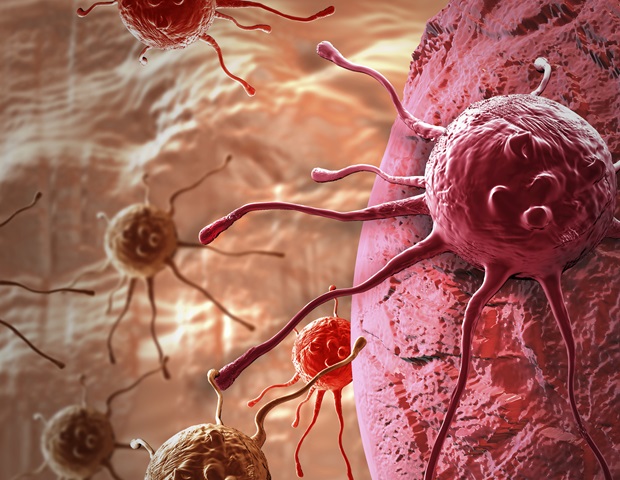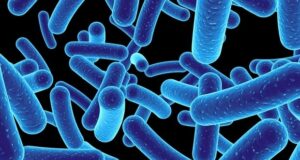
Preventing the cell’s protein factories from making the notorious cancer-causing protein MYC could stop out-of-control tumors.
For decades, scientists have tried to stop cancer by disabling the mutated proteins that are found in tumors. But many cancers manage to overcome this and continue growing.
Now, UCSF scientists think they can throw a wrench into the fabrication of a key growth-related protein, MYC, that escalates wildly in 70% of all cancers. Unlike some other targets of cancer therapies, MYC can be dangerous simply due to its abundance.
In a paper that appears Feb. 4 in Nature Cell Biology, researchers at UC San Francisco describe how to curb MYC levels. They discovered that another protein, called RBM42, makes cells churn out MYC.
Disrupting RBM42 in pancreatic cancer cells, one of the deadliest cancers, stopped them from growing. The researchers now think drugs could be developed to do the same in a host of other fast-growing cancers that are driven by MYC. By blocking RBM42, such drugs would effectively block MYC.
MYC is what we see when a cancer is resilient to anything we try to do to defeat them. Now that we can see the machinery that controls the amount of MYC, there may finally be a way to stop it.”
Davide Ruggero, PhD, professor of urology at UCSF and senior author of the paper
Why so much MYC?
MYC was first identified in the 1970s by UCSF Nobel Laureates Michael Bishop, MD, and Harold Varmus, MD. They found MYC while studying cancers that are caused by viruses. MYC was a normal protein that only took on a malevolent role in cancer. The discovery revolutionized cancer research and cancer care.
Unlike other cancer-causing factors, though, cancerous MYC isn’t always mutated. Cells produce MYC unceasingly to become cancerous without a mutation in the MYC gene directly. And pathologists use it as a microscopic marker for fast-growing cancers.
“Everyone knows how important MYC is for cancer, but there are no drugs to block it,” said Joanna Kovalski, PhD, first author of the paper. “So, we instead looked toward how MYC is actually made.”
Kovalski used a method called CRISPRi to hunt for factors that influence how much MYC was produced in cancer cells. Surprisingly, the experiment pointed to an obscure protein known as RBM42, which has not attracted much attention until now.
Poring over genomic data from pancreatic cancer patients, Kovalski found abundant RBM42 in cells with lots of MYC. And the more RBM42 and MYC patients had, the worse they did.
Hijacking the protein assembly line
Kovalski and Ruggero wanted to know how RBM42 influenced the production of MYC.
Like any protein, MYC is built using the instructions that are stored in the MYC gene. First, in a process called transcription, the cell uses these instructions to make a blueprint, called mRNA. Then, in a process called translation, the cell’s protein factories, called ribosomes, use this mRNA to make MYC protein.
The scientists were surprised by what they found. When they disrupted RBM42, the cancer cells still produced MYC mRNA but stopped producing the MYC protein. This suggested that RBM42 was only involved in the second part of the process: the translation of mRNA into protein.
Further experiments showed why. RBM42 reshaped the MYC mRNA blueprint to make it better for processing by ribosomes. It also directed these mRNAs to the ribosomes – which churned out copious amounts of MYC. RBM42 ensured that MYC received preferential treatment from the cell’s protein factories.
“Proteins like RBM42 and MYC exist in every cell but are normally restrained,” Ruggero said. “During cancer, we saw that RBM42 behaved quite differently, hijacking the ribosomes to work with these specific mRNAs and do the cancer’s bidding.”
Drop the MYC
The researchers tried interfering with RBM42 in cancer cells in petri dishes, and then in mice. In both cases, when they removed RBM42, the ribosomes stopped making MYC, and the pancreatic tumors stopped growing.
“RBM42 really seems to be the Achilles’ heel for some of the worst cancers,” Ruggero said.
Kovalski, Ruggero, and their UCSF colleagues believe small molecules could intervene in this process like molecular wrenches jamming cancer’s gears.
“Translation control deserves to be front and center in our efforts to treat cancer,” Kovalski said. “We now have great footing to interfere with the fastest-growing cancers and make a difference for patients.”
Source:
Journal reference:
Kovalski, J. R., et al. (2025). Functional screen identifies RBM42 as a mediator of oncogenic mRNA translation specificity. Nature Cell Biology. doi.org/10.1038/s41556-024-01604-7.




